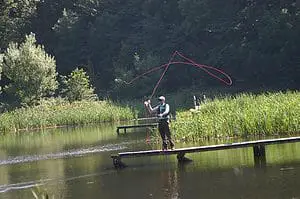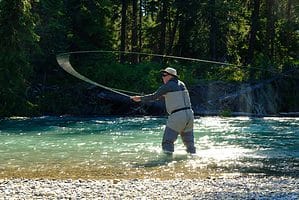Disclosure: Some posts contain affiliate links, which earn us a commission if you make a purchase through them. Positive Fishing © participates in various affiliate networks including the Amazon Services LLC Associates Program.
Skilled fly anglers make casting a fly rod look extremely easy. To a novice, all it looks like is someone moving their arm back and forth and pointing the rod in the direction they want their fly to go.
It’s not until someone picks up the rod that they’ll understand how complicated the process is. Casting a fly rod is a form of art, and it takes a significant amount of practice to learn a variety of techniques and still land fish.
In this article, I will cover the most important fly-casting factors for beginners:
- Getting Started
- The Grip
- The Stance
- The Motion
- Overhead Cast
- Roll Cast
- Practice Tips
Getting Started
When you’re ready to begin casting a fly rod, it’s best to do it in an open area. You don’t want to learn how to cast while you’re hitting trees and getting snagged on everything around you.
If you’re going to start learning on the water, go to a large unobstructed pond or lake. If you don’t have simple access to water, a park or your backyard will provide plenty of room. It’s not even necessary to attach a fly to your line.
The Grip
There are a variety of grips you can have with your fly rod, but the standard grip is to place your thumb on the top of the cork and let your other fingers grasp the underside. This grip will help you keep the rod pointed in the proper direction and give you the most control possible. Grip the fly rod in the middle of the cork. If you grip on either end, you’ll find that the balance of the rod is wrong.
Don’t grip the rod too hard. If you do, you’ll find that your casts don’t end up where you want and you’ll likely be extremely sore at the end of the day. Keep a loose and comfortable grip and you’ll be good to go.
The Stance
When you’re learning to cast, keep your feet shoulder-width apart and keep a strong base. If you’re going to make shorter casts, you can directly face the water and complete the arm motion. If you’re hoping to make longer casts, it’s best to place one foot in front of the other in more of a staggered position.
If you cast with your right hand, place your left foot out front like you would when throwing a ball. If you cast with your left hand, place your right foot out front like you would when throwing a ball.
This will give you a perfect balance. As you fish more, you’ll find yourself in situations where you can’t have the exact stance that you want, but when you’re learning, it’s best to do so with the proper techniques.
The Motion
There are numerous casts that anglers can use throughout their fly fishing career. Many anglers learn standard casting techniques to begin and then move to a more advanced option.
The overhead cast and roll cast will be enough to fish the majority of water in the world. If you need to specialize, you’ll already have the casting motion down and you’ll have to change your form a bit for a spey cast or figure 8 cast.
Many people will try to teach people by telling them to keep their arm in a straight line moving from 10 and 2 on a clock. Fly casting isn’t this rigid. There’s more fluidity to the fly-casting motion and if you stay stuck on the straight-line movement, you’ll lose the ability to make certain movements. You don’t necessarily want to go past 10 and 2 otherwise your line will hit the ground behind you and slap the water as you’re making the false casts. A false cast is when you’re casting over the water and attempting to get enough line out.
The motion you should imagine is hammering a nail into a wall. It’s a swift, parallel motion that suddenly stops. If you do this motion both forwards and backward, you’ll find that your line moves much further and in a more fluid motion. You want your arm to stay on a similar axis, but the motion shouldn’t be like the arm of a metronome. It should be a bit more staggered.
A different way of thinking about casting a rod is to imagine you are trying to throw something with a shovel. With the shovel over your shoulder, you would have to start the forward motion slowly to ensure nothing is going to fall out of the shovel. As you bring the shovel forward, you increase the speed and suddenly stop when you’re ready to launch.
This is similar to casting a fly rod. You want to start the forward cast slowly, then increase the speed and make a more sudden stop to let the line go.
Overhead Cast

The overhead cast is the most popular casting method you’ll see. You’ll see an angler facing the river or in their staggered stance and casting the rod above their head until enough line is out to get to where they want to cast.
The Start
To start an overhead cast, use the staggered stance described above and begin pulling the line from your reel. As you’re learning, you want to have line already pulled out of the reel as you’re making your cast. With the hand that is not going to be doing the casting motion, grab onto the fly line about two feet before the bottom eyelet on the rod.
Begin the Casting Motion
Once you have these steps done, begin the shovel-throwing motion. Start with the rod behind your shoulder and bring it forward. Remember to start slowly to pick your line off the ground and finish with a more firm motion. Once you see all of your line moving forward, you can do that same motion backward over your shoulder.
As you practice, you’ll be able to feel when the line is losing momentum so you know when you begin casting the other way. Once this motion is completed smoothly, you’ll feel the line start moving nicely through your other hand.
It will take some practice and you may only feel a few inches of line move at a time. After a while, you’ll have several feet of line move through your hand with each “false” cast.
Common Mistakes
Many anglers will find themselves moving their arms too quickly and having fly line fall all over them. Stay patient and don’t start casting backward or forwards until all of your line has unfurled. You want all of your line to be moving before you make your casts. Only one hand is going to be doing the casting.
Also, beginner anglers will likely find themselves having too much line out of their reel so they’re unable to keep the momentum going. As you begin practicing, you really only need ten or so feet of fly line out. This amount is far more manageable! As you gain confidence, you can pull more line out.
You may have to break down the motion step-by-step. Start with the forward motion and then move to the backward motion. Eventually, you’ll start to feel a smooth cast.
Roll Cast

The roll cast is another extremely common casting motion that many anglers find themselves doing in tighter conditions with some small restrictions. If you’re fishing on a shoreline with quite a bit of vegetation and you don’t have room for a backcast, then the roll cast will work out well.
The Start
To start the process of a roll cast, hold your rod just behind your head with your hand pointing straight up in the air. It should look like you have an antenna sticking out of the back of your shoulder. You should have about 10 to 15 feet of fly line out of the reel.
With your other hand, hold the excess fly line about 2 or 3 feet below the bottom islet on your rod. You can hold the line in front of you on the opposite shoulder of the rod. The line should make a “d” shape across your body. Once you’re all in position, you can use the forward casting motion of the overhead cast.
The Motion
Imagine you’re throwing something with a shovel and the shovel is starting over your shoulder and behind your head.
You start slow and increase the speed until you suddenly stop the rod so the line can shoot out. When you’re finishing the cast, the rod tip should be pointed directly at your target and the tip should be at about chest or eye level. You don’t want to follow through straight down otherwise your line will hit the water and not go nearly as far as you would like.
Practice Tips

In fly fishing, practice is truly going to make a massive difference. The more prepared you are before you hit the water, the better off you’re going to be in the long run.
Start Slow and Simple
When you’re looking to practice, don’t start trying to learn a new technique until you’ve mastered the previous technique. If you’re working only on the forward motion, stick with that until you feel as if you’ve learned it. Then you can build on top of what you have been doing!
Put Yourself in Positions to Succeed
Confidence is a huge factor in fly fishing. If you’re not confident in your abilities, you’re not going to fish as well. If you don’t fish as well as you’d like, you’ll find yourself not landing as many fish.
Keep yourself comfortable and move on to more challenging activities once you feel ready.
Know your Style of Learning
If you’re a visual learner, then utilize visual tools to help you learn. The more you understand how you learn, the faster you will learn.
Tip: One of the best ways to continue to make better, more accurate, and longer casts is to practice on the grass, if necessary go out to a wide-open area like a park or field.
Final Thoughts
Learning to fly cast effectively takes some patience, time, and effort. Time well spent on perfecting your casts will result in better and more catches.
Getting your fly in the right piece of water and also being able to cast that bit further can make all the difference.
I hope you enjoyed reading my article, you can learn more about the basics of how to start fly fishing which covers all the gear, set-up, and tips for beginners or those new to the sport.
- Wading Belt Essentials: Ensuring Safer Fishing - January 9, 2024
- Fishing For Catfish (Top Tips, Bait, & Gear To Catch The Big 3) - October 20, 2022
- Fishing Line Strength Vs. Diameter Chart: Why Is It Important? - October 12, 2022

